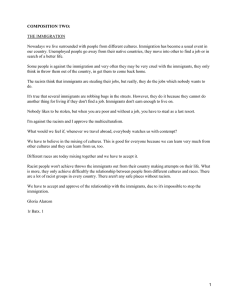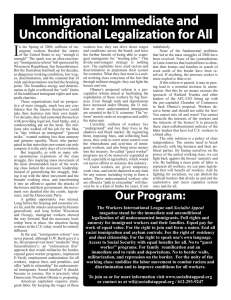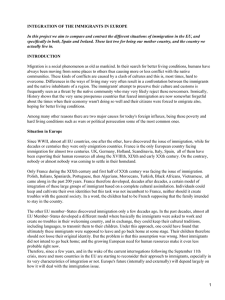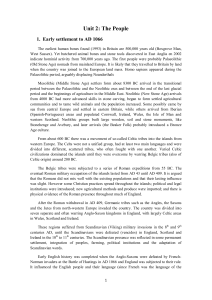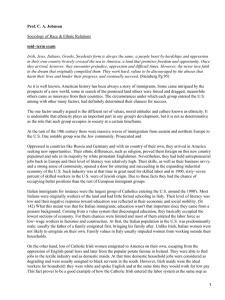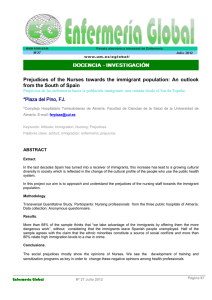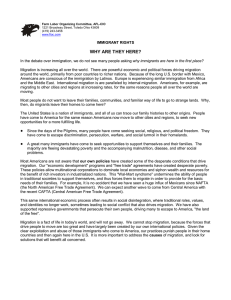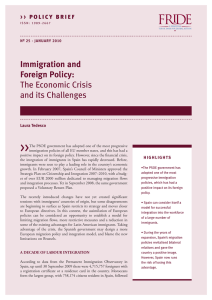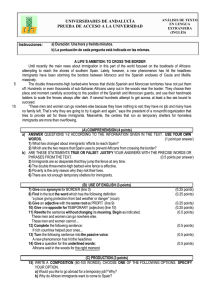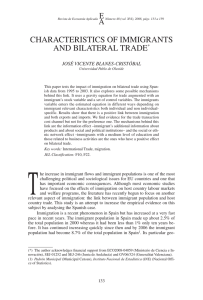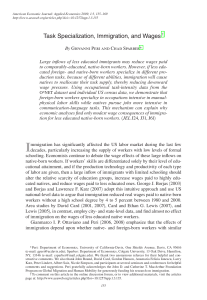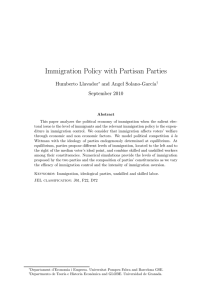1 The National Management of Migration Flows: The British
Anuncio
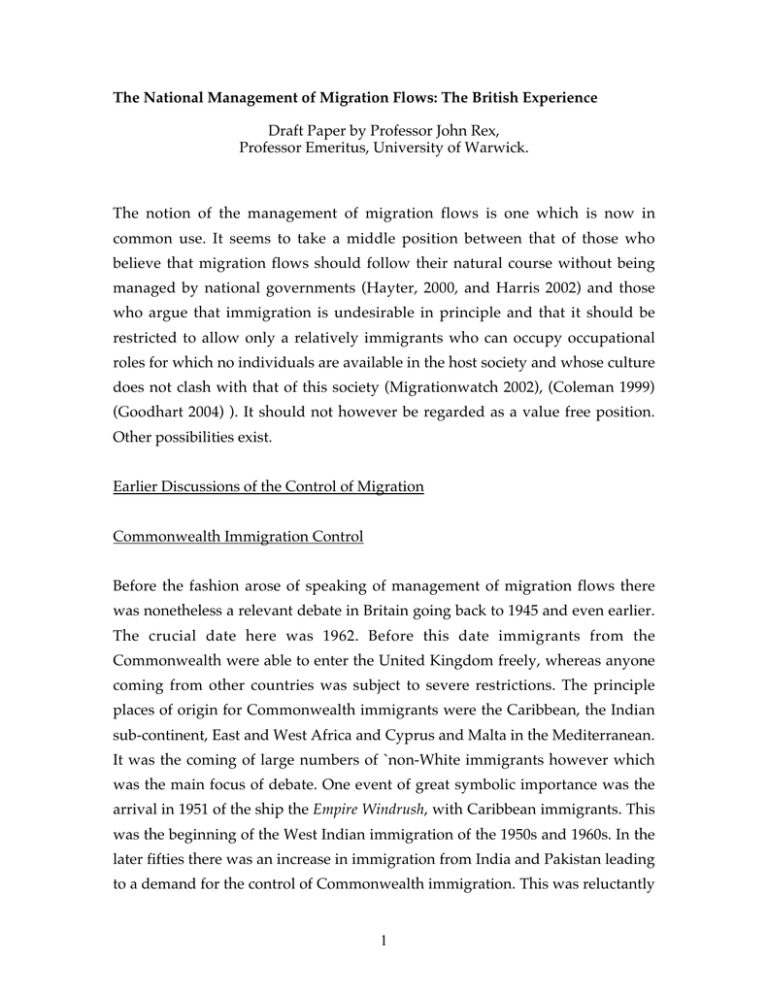
The National Management of Migration Flows: The British Experience Draft Paper by Professor John Rex, Professor Emeritus, University of Warwick. The notion of the management of migration flows is one which is now in common use. It seems to take a middle position between that of those who believe that migration flows should follow their natural course without being managed by national governments (Hayter, 2000, and Harris 2002) and those who argue that immigration is undesirable in principle and that it should be restricted to allow only a relatively immigrants who can occupy occupational roles for which no individuals are available in the host society and whose culture does not clash with that of this society (Migrationwatch 2002), (Coleman 1999) (Goodhart 2004) ). It should not however be regarded as a value free position. Other possibilities exist. Earlier Discussions of the Control of Migration Commonwealth Immigration Control Before the fashion arose of speaking of management of migration flows there was nonetheless a relevant debate in Britain going back to 1945 and even earlier. The crucial date here was 1962. Before this date immigrants from the Commonwealth were able to enter the United Kingdom freely, whereas anyone coming from other countries was subject to severe restrictions. The principle places of origin for Commonwealth immigrants were the Caribbean, the Indian sub-continent, East and West Africa and Cyprus and Malta in the Mediterranean. It was the coming of large numbers of `non-White immigrants however which was the main focus of debate. One event of great symbolic importance was the arrival in 1951 of the ship the Empire Windrush, with Caribbean immigrants. This was the beginning of the West Indian immigration of the 1950s and 1960s. In the later fifties there was an increase in immigration from India and Pakistan leading to a demand for the control of Commonwealth immigration. This was reluctantly 1 conceded by the Conservative Home Secretary, Mr Butler. According to the Immigration Control Act of that year new immigrants from the Commonwealth, other than dependents were restricted to a total of 7000 and these were to be either those with jobs to come to or those with special skills for which no British candidates were available. In the 1962 Act there was also provision for a small number of others at the discretion of the British government. The Labour Leader, Gaitskell, declared that the Labour Party would reverse the Act using evidence provided by the geographer Ceri Peach (1967) that there was a natural process of immigration control which led to West Indian immigration varying according to the numbers of jobs available. In fact when the Labour Party did come to power in 1964 it accepted the basis of the 1962 Act and actually strengthened it by abolishing the discretionary category. Labours Acceptance of Racially Selective Immigration Control Within the Labour government there was much discussion about the principle of immigration control. Richard Crossman the Minister of Housing and Local Government recorded his belief that, since the electorate were in favour of immigration control, the government should have immediately grasped the nettle of accepting it. (Crossman 1979) Roy Hattersley on the other hand sought to resolve the sense of guilt in the Labour Party by arguing that “without control integration is impossible” but that “without integration control is morally indefensible” (Rex and Tomlinson 1979) Hattersley and Crossman both saw nonWhite immigration as the problem. The Hattersley formula was spelt out in institutional terms. Integration was to be achieved through the setting up of a National Committee for Commonwealth Immigrants (NCCI) chaired by the Archbishop of Canterbury and including well known spokesmen for the various immigrant groups1 who would represent the immigrants politically The Archbishop also expressed his concern that the stigma imposed on immigrants by the control process might make integration 1 The representatives of the immigrant communities chosen were DR David Pitt a West Indian doctor and a one-time candidate in a Parliamentary election, Vishnu Sharma a leading Indian trade unionist and Hamza Alavi a University lecturer in Manchester. 2 impossible. When he continued to express these fears the NCCI was abolished and replace by the Community Relations Commission which it was said would help to integrate immigrants paternalistically through various forms of social work rather than giving them a political voice. The other element involved in integration was a legal one. A Race Relations Act was passed in 1964 outlawing racism in public places and this was extended in 1968 to cover housing and employment2. The implementation of this Act was assigned to a Race Relations Board headed by Mark Bonham Carter. The two separate bodies the Community Relations Commission and the Race Relations Board were eventually combined in A Commission for Racial Equality which was set up in 1976. East African Asians and Patriality A central problem arose from the fact that the 1962 Act and the policy of the Labour party after 1965 were designed to deal with the problems of and those caused by non-White immigrants. This became clear in 1968 when large numbers of Asians from East Africa fearing the persecution of Idi Amin wished to move to Britain. Most of these had been given the option when the former East African colonies became independent of choosing British citizenship rather than that of one of these East African states. Many chose to do so and could not be refused permission under the 1962 Immigration Control Act. The British Home Secretary, James Callaghan therefore rushed through legislation to require these East African Asians to be queued so that only small numbers could be admitted each year3. Thus a new contingent was added to the non-White British population. A second fact was that, since the Commonwealth Immigration applied in principle to immigrants from the Old White Commonwealth some way had to be found of distinguishing them and exempting them from immigration control. 2 The implementation of the 1968 Act was considerably weakened by the fact that it depended on the co-operation of Local Councils with regard to Housing and the trade unions with regard to employment. 3 In 1972 however in the face of Idi Amin’s persecution and the failure of an attempt change East Africa policies the Conservative Minister of Labour Robert Carr agreed to their admission. At first they were brought to camps and then deliberately dispersed before many joined up with existing East African Asian communities particularly in the city of Leicester... 3 This was achieved in 1971 through the introduction of the notion of patriality in the Immigration Control Act of 1971 which freed those with a recent British ancestry from immigration control while assimilating anyone without such a patrial connection to the same status as aliens. The period after 1971 saw two contrasting developments. On was the growth of racism, the other a gradual evolution of organisations and policies on the integration of minorities. Racist Mobilisation in the Nineteen Sixties Racism had been the driving force which led to the racially selective Immigration Control Act of 1962.It was the pressure from Immigration Control Associations in the Midlands which led to the passing of the 1962 Act. In the 1964 elections the Labour Foreign Affairs spokesman Gordon Walker lost the Smethwick seat against the overall swing to Labour when some Conservative canvassers used the slogan “if you want a nigger for your neighbour vote Labour”. When another Labour M.P. resigned in a safe Labour seat in London to make way for Gordon Walker he was again defeated. In 1968 the leading Conservative Enoch Powell made his notorious speech in Birmingham in which he envisaged “rivers of blood” if Black and Asian immigration continued. Mrs Thatcher in opposition suggested that the British people feared being “swamped” by Black and Asian immigrants. Policy and Organisations directed to Achieving a Non-Racial Citizenship In opposition to this a number of key figures began to lay the ground for immigration integration. Starting from the assumption that class divisions were being overcome through the social citizenship offered by the Welfare State (Marshall 1951) many followed a famous statement by Roy Jenkins the Home Secretary, addressing a meeting of Non-Governmental Organisations arranged by the NCCI in which he defined integration of immigrants “not as flattening process of uniformity but cultural diversity coupled by equal opportunity in an atmosphere of mutual tolerance” (Joppke 1999). Edward Boyle the Conservative Member of Parliament led a section of the Party in refusing to make race an election issue in 164 and 1970. Anthony Lester a leading Labour lawyer sought to 4 distance policy discussion from continuing racial conflict by proposing anti-racist policies and he and Mark Bonham Carter of the Race Relations Board arranged for a research programme which would uncover the extent of racial discrimination. This research was carried out by the organisation Political and Economic Planning (PEP) and led to a book Racial Discrimination in Britain, (Daniel 1966) which was followed by three later studies carried out by PEP and its successor the Policy Studies Institute (PSI) (Smith 1974, Brown 1982, and Modood et al 1997). The assumption underlying all these developments was that a British government would be committed to anti-racism as a matter of policy. How far there was a political will to carry out such a policy was, however, to be doubted. Successive governments also felt it necessary to respond to racist pressures in the public and the media. Such problems continued when the Runnymede Trust (Runnymede 2000) produced a report calling for the recognition that Britain was a multi-ethnic society and of the adoption of antiracism as a policy in all institution. The report was launched by the Home Secretary, Jack Straw, who as a politician was subject to pressures from the Focus Groups through which the government took account of public opinion... Ethnic Questions in the Census An important question which had to be faced in formulating anti-racist, antidiscrimination policies was that of discovering the size of minorities. In France while statistics of birthplace and nationality were recorded, it was thought entirely improper to record the ethnicity of its citizens. In Britain this was not the case. The combating of racial discrimination and disadvantage through redressive action was thought to require statistics of the numbers of people thinking of themselves as belonging to an ethnic groups regardless of birthplace. In 1981 the Census began to pursue this question by asking for the birthplace of individuals and of their parents. In 1991, however, a new kind of question was introduced. Individuals were now asked to what ethnic group they thought of themselves as belonging. They were offered a choice of White, Black African Black Caribbean or Black Other, Indian Pakistani, Bangladeshi or Sri Lankian, Chinese, Other Asian or Other Other. This question was criticized by many as 5 illogical and potentially racist. Clearly White is not really an ethnic category. Blacks are not allowed to see themselves as belonging to the same ethnic group as White British. The Asian categories seem to relate to birthplace. The Whites are a mixed group including not merely the native British but Irish Cypriots, Maltese and Europeans. Finally there appears to be no recognition of groups of mixed descent. There was also no religious question since this had been opposed by the powerful Jewish lobby and very often the figures for Pakistanis and Bangladeshis were taken as surrogates for the number of Muslims. Eventually a religious question was introduced in the 2001 census. Some of the problems relating to the ethnic question were discussed in a pamphlet written for the Runnymede Trust by Kenneth Leech (Leech 1989) Despite the criticism of the ethnic question it came to be supported by many social scientists and policy makers in the nineties. It was said that only by knowing who were placed or placed themselves in these categories would it be possible to discover the extent of discrimination and disadvantage, and correct it. If the main basis of discrimination was colour it was argued it was important to make a first distinction between Whites and non-Whites. After this distinctions could be made between various Black and Asian groups to show which ones suffered the most severe forms of discrimination. This argument is understandable, but it is interesting to notice that in the Fourth Survey of Disadvantage carried out by Modood and his colleagues the census categories are replaced by other more sophisticated ones. Asylum Seekers and Illegals After the passing of the immigration control acts of 1962 and 1968 the entry of immigrants to seek work ceased apart from the continuing inflow of dependents. In this immigration stop Britain led the way in Europe where other Western European countries imposed the stop in the early seventies. Thereafter the main incomers were asylum seekers or more broadly political as distinct from economic migrants. Asylum seekers were admitted under the Geneva Convention of 1951 which declared that to claim refugee status an individual must have “a well-founded fear of persecution on the ground of race, religion, 6 nationality, membership of a particular social group or political opinion” There were 85,865 such asylum applications in Britain in 2002. 42% 0f these were granted refugee status and another 10% given “exceptional leave to remain” Of the others some were removed and some returned voluntarily to their homelands. The British government sought to reduce the numbers of asylum seekers by declaring a number of countries as safe, by requiring applicants to obtain visas from British offices in their home country or calling on potential carriers to refuse to carry them. A much larger group than those who could claim asylum were those who while not measuring up to the Geneva Convention criteria found themselves living in intolerable political conditions because of civil war or ecological disaster. The British government usually refused to recognize those coming from these circumstances as refugees and it was often claimed that they were really economic migrants masquerading as refugees. In some cases there was truth in this in that with other immigration routes being closed some of those who wished to migrate for economic reasons chose the claim of refugee status as the only remaining route possible. For governments the justification for accepting political migrants was quite different from that for economic migrants. In the latter case they could claim that the migrants were necessary to fill otherwise unfilled jobs, In the case of political migrants they had to argue that whether or not the country benefited from their presence the justification for accepting them could only rest upon some legal or moral requirement. Some could, of course be shown to have useful professions or skills as was often the case with Jewish refugees in the thirties, but their usefulness in this regard was usually only seen retrospectively and they were regarded as dangerous individuals who should be returned to their country of origin as soon as possible. In the case of Gypsies or Roma the migrants from these groups clamed that they were persecuted as a group whereas they could only be recognized as refugees if they feared individual persecution. The admission of gypsies fro the Czech Republic, Slovakia and Romania was often at the centre of hostility to immigrants as such. Some failed asylum seekers disappeared into the community where they joined a number of other groups of illegal and undocumented workers. Some of these were smuggled in to the country by people traffickers, but in large parts of the 7 agricultural and construction industry employers relied upon so-called “gangmasters” to provide then with labour at a minimum cost. These illegal workers were in a dilemma. Their conditions in terms of wages and housing were appalling but if they sought to join trades unions their presence would become known and they would be deported. It now seems that there is black hole in employment statistics involving unknown numbers of illegals. Class Race and Ethnicity from the Eighties to the present day The problem of transcending class divisions and that of integrating immigrants were as I have argued in discussing Marshall and Jenkins continually intertwined. The interesting thing about Thatcher’s politics was not that it opposed immigrant integration or treated immigrants as scapegoats. In fact her belief in capitalism led her to take on the working class headed by the trades unions and to defeat it. Her successor, John Major moreover did not oppose immigrant integration. Hi ideal was a classless Britain in which anyone of any background could get to the top. Finally New Labour policy under Blair dropped any specific discussion of ethnic minorities as it emphasised replacing dependence on welfare benefits with getting individuals back into the labour market. The Northern Disturbances and the Debate about Multiculturalism In any discussion of policy alternatives with regard to immigrant minorities Britain was usually classified as one of a number of countries which supported multiculturalism as opposed to the assimilationism which was seen as the French ideal and the notion implicit in the German gastarbeider system which in principle refused to see incoming workers as permanent. This is a question which I have discussed extensively in my book Ethnic Minorities in the Modern Nation State, (Rex 1996). When, however there were violent disturbances in some of the cities of Lancashire and Yorkshire in 2002, the diagnosis of their problems was attributed to the fact of segregation in housing and education. A report carried out for the Home Office by Cantle the former Chief Executive of Nottingham 8 spoke of the need for community cohesion cutting across ethnic boundaries, (Cantle 2001) while in Bradford an existing report by Herman Ouseley (Ouseley 2001) )was used in a similar way. The idea of multiculturalism espoused by Jenkins now appeared to be dead and this ideas endorsed by the Director of the Commission for Racial Equality Trevor Phillips in 2004. (BBC April 2004). The Home Secretary David Blunkett now organised ceremonies in which immigrants would declare their loyalty to Britain and called for an insistence by local authorities that all immigrants should learn the English language and also learn about English values. A scheme for identity cards was also proposed with the emphasis being placed upon immigrants having such cards. All of these changes suggest that problems of integration were now being discussed in terms of a new vocabulary and that British thinking had moved towards the French assimilationist ideal. Muslims and Islamophobia after 9/11 A number of developments in Britain had opened up divisions between Muslims and the British even before the attacks in New York and Washington of September 9th 2001. Migrantwatch had suggested that as immigration became restricted Muslims should be kept out because they were difficult to assimilate (Coleman 1999). The ideas of Samuel Huntington in the United States had fostered the notion that Islam and the Christian and secular West represented different and incompatible stage of development (Huntington 1993) In Britain the Rushdie Affair produced renewed hostility to Muslims symbolised by the burning of the Rushdie book (Samad 1992) The Runnymede Trust published a report on Islamophobia (Runnymede Trust 1997) drawing attention to the extent of hostility to Muslims. If this were not enough after September 11th 2001 Muslims came to be viewed as potential terrorists. Querying National Management of Migration Flows. It is to be hoped that this review of the management of immigrant settlement in Britain will put the title of this conference in perspective. It would seem that this 9 managerial approach to the problem actually takes sides by suggesting that immigration flows constitute a potential threat to political stability. 10 References Abbas, T., (2005) (Editor) Muslim Britain, Communities under Pressure, Zed books distributed by Palgrave MacMillan, London and New York Acton, T., and Kegan, P., (1974), Gypsy Politics and Social Change, Routledge, London. BBC News 10thApril 2004 Brown, C., (1982) Black and White Britain, Heineman Educational Books, London Cantle, T., (December 2001), Building Cohesive Communities: A Report of the Ministerial group on Public Order and Community Cohesion, Home Office, London. Coleman, D., (1999) Contributions to Radio Discussions, e.g. Rites of Refuge, BBBC Home Service 16 12 99. Crossman, R., (1979), The Crossman Diaries, Selection from the diaries of a Cabinet Minister 1964-70, introduced and edited by Anthony Howard, Magnum Books, Methuen Paperbacks, London. Daniel, W., (1966), Racial Discrimination in England, Harmondsworth, London Goodhart, D., (2004), The Strangers Among Us, Originally in Prospect February 2002 London, Reproduced in the Guardian February 26th 2004. Harris, N., (2002), Thinking the Unthinkable: The Myth of Immigration Control, I.B.Taurus, London. Hayter, T., (2000), Open Borders: the New Common Sense Heinemann, B.W.Junior (1972), The Politics of Powerlessness: A study of the Campaign Against Racial Discrimination, Oxford University Press, Oxford. Home Office (1963), Commonwealth immigrants Act, 1962; control of immigration statistics for July 1962-30 June 1963, Home Office, Cmnd 2151 Huntington, S., (1993), The Clash of Civilizations in Foreign Affairs, Summer 1993 Vol 72 No3, Washington. Joppke C., (1999) Immigration and the Nation State: the United States, Germany and Great Britain, Oxford University Press. Oxford. Leech, K., (1989), A Question of Dispute: The Debate about an “Ethnic” question in the Census, Runnymede Trust. London 11 Marshall, T.H. (1951), Citizenship and Social Class, Cambridge University Press, Cambridge Mason,P. (1976), The Institute of Race Relations, Centre for Southern African Studies University of York. Migrationwatch UK. (2002) Bulletin No7, Submitted to the House of Commons 2002. Modood et al (2000), Ethnic Minorities in Britain: Diversity and Disadvantage, Policy Studies Institute, London. Mullard, C., (1985), Race Power and Resistance, Routledge and Kegan Paul London 1985 Ouseley, H., (July 2001), Community Pride and Prejudice, Bradford Vision, Bradford City Council Peach, C., (1967) West Indians as a Replacement Population in England and Wales, Extract from Social and Economic Studies, Vol 16 No 3. pp 289-294 Rex, J., (1996) Ethnic Minorities in the Modern Nation State, MacMillan, Basingstoke. Rex, J., and Tomlinson S., (1979), Colonial Immigrants in a British City: A Class Analysis, Routledge and Kegan Paul, London Rex, J., (2002) “Islam in the United Kingdom” in Shireen Hunter, Islam Europe’s Second Religion”, Praeger New York in conjunction with The Council for Strategic and International Studies, Washington. Runnymede Trust (1997), Islamophobia: A Challenge to us all, Runnymede Trust London. Runnymede Trust (2000).The Future of Multi-Ethnic Britain – The Parekh Report, Runnymede Trust, London. Samad, Y., (1992) Book-burning and Race Relations:Political Mobilisation of Asians in Bradford, New Community, Vol 8 No 4, London. Smith, D., (1974) Racial Disadvantage in Britain, Hammondsport, London. 12
